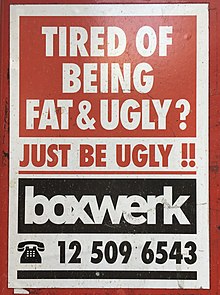
Back تسويق العصابات Arabic Partizan marketinqi Azerbaijani Герила маркетинг Bulgarian Màrqueting de guerrilla Catalan Guerillový marketing Czech Guerilla-Marketing German Publicidad de guerrilla Spanish Gerrilla marketin Basque بازاریابی پارتیزانی Persian Sissimarkkinointi Finnish

| Marketing |
|---|
Guerrilla marketing is an advertisement strategy in which a company uses surprise and/or unconventional interactions in order to promote a product or service.[1] It is a type of publicity.[2] The term was popularized by Jay Conrad Levinson's 1984 book Guerrilla Marketing.
Guerrilla marketing uses multiple techniques and practices in order to establish direct contact with potential customers.[3] One of the goals of this interaction is to cause an emotional reaction in the clients, and the ultimate goal of marketing is to induce people to remember products or brands in a different way than they might have been accustomed to.
As traditional advertising media channels—such as print, radio, television, and direct mail[4]—lose popularity, marketers and advertisers have felt compelled to find new strategies to convey their commercial messages to the consumer. Guerrilla marketing focuses on taking the consumer by surprise to make a dramatic impression about the product or brand.[5] This in turn creates buzz about the product being marketed. It is a way of advertising that increases consumers' engagement with the product or service, and is designed to create a memorable experience. By creating a memorable experience, it also increases the likelihood that a consumer, or someone who interacted with the campaign, will tell their friends about the product. Thus, via word of mouth, the product or service being advertised reaches more people than initially anticipated.
Guerrilla marketing is relatively inexpensive, and focuses more on reach rather than frequency.[6] For guerrilla campaigns to be successful, companies generally do not need to spend large amounts of money, but they need to have imagination, energy and time.[7] Therefore, guerrilla marketing has the potential to be effective for small businesses, especially if they are competing against bigger companies.
The message to consumers is often designed to be clear and concise. This type of marketing also works on the unconscious mind,[6] because purchasing decisions are often made by the unconscious mind. To keep the product or service in the unconscious mind requires repetition, so if a buzz is created around a product, and if it is shared amongst friends, then this mechanism enables repetition.[7]
- ^ Kenton, Will. "Guerrilla Marketing". Investopedia. Retrieved 2019-05-14.
- ^ "What Is Guerrilla Marketing?". Creativeguerrillamarketing.com. Archived from the original on 2017-03-20. Retrieved 2017-03-01.
- ^ Bernard Cova & Marcel Saucet, "The Secret Lives of Unconventional Campaigns: Street Marketing on the Fringe", Journal of Marketing Communications, 2014;Jay Conrad Levinson, 1984
- ^ Belch, Michael A.; Belch, George E. (2008-06-05), "Integrated Marketing Communications", The International Encyclopedia of Communication, John Wiley & Sons, Ltd, doi:10.1002/9781405186407.wbieci038, ISBN 9781405186407
- ^ What is Guerrilla Marketing, 2015
- ^ a b Levinson, Jay Conrad (2007). Guerrilla Marketing: Easy and Inexpensive Strategies for Making Big Profits from Your Small Business. Piatkus. ISBN 978-0-7499-2811-7.
- ^ a b Bourn, 2009